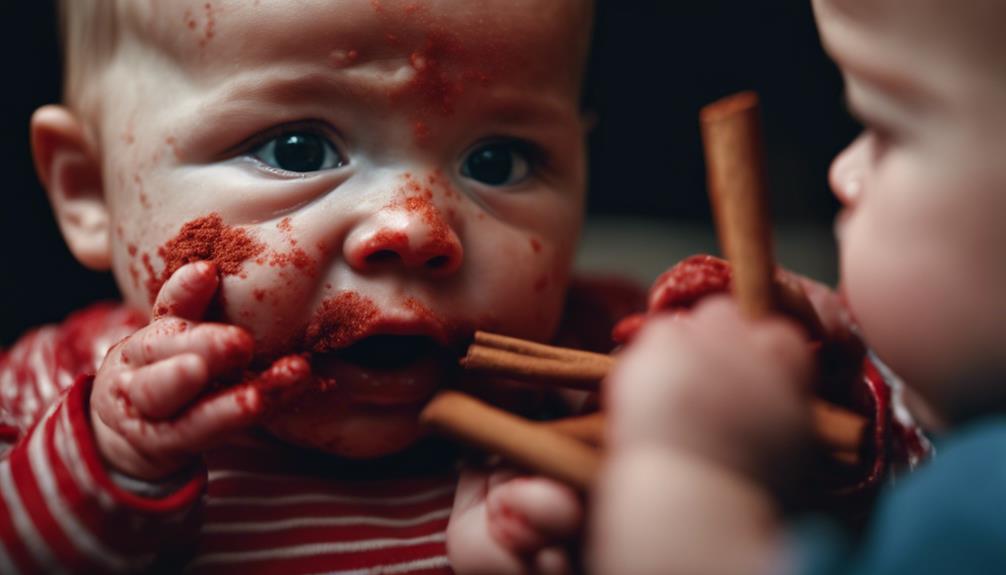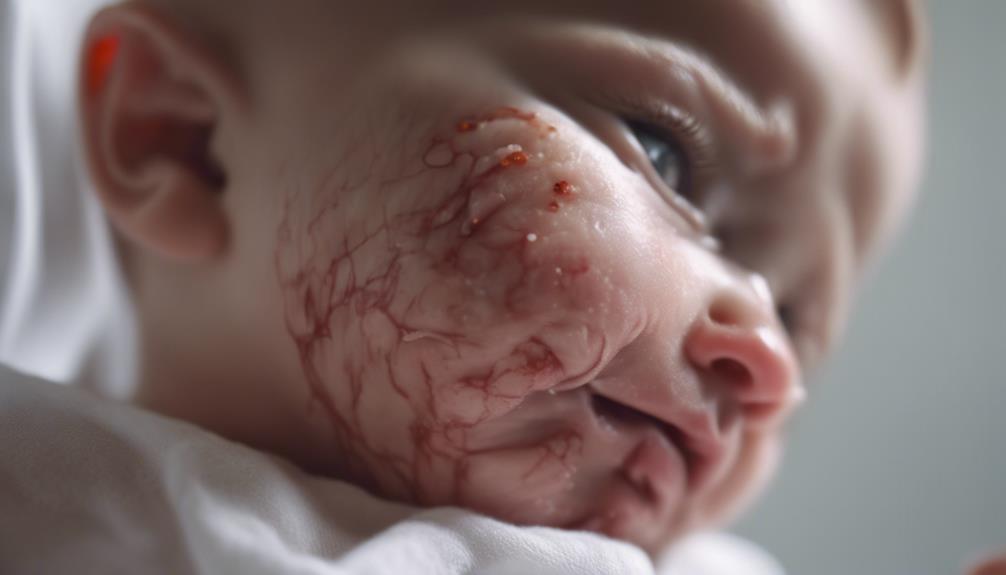If your baby displays skin rashes, itching, or gastrointestinal problems such as vomiting after contact with cinnamon, they may have an allergy. Respiratory symptoms like coughing or wheezing and swelling can also indicate a reaction. Recognize these signs to manage the allergy – monitor symptoms, steer clear of cinnamon exposure, and seek professional advice. Check food labels and inform caregivers about the allergy. Be careful when introducing new foods. Watch for skin irritation, respiratory distress, or anaphylaxis. Act promptly to guarantee your baby's health and well-being. More insights on handling and recognizing cinnamon allergies await.
Key Takeaways
- Skin irritation like itching and redness is a common symptom in babies with cinnamon allergies.
- Watch for respiratory symptoms such as coughing and wheezing in infants allergic to cinnamon.
- Gastrointestinal issues like vomiting and diarrhea can indicate a cinnamon allergy in babies.
- Swelling, both externally and internally, may occur as a symptom of a cinnamon allergy in infants.
- Severe reactions like anaphylaxis, which require urgent medical attention, can be a symptom of cinnamon allergy in babies.
Cinnamon Allergy Symptoms in Babies
If your baby has a cinnamon allergy, they may exhibit various symptoms that can affect their skin, gastrointestinal system, and respiratory system. Skin irritation such as redness, itching, or hives may occur upon contact with or ingestion of cinnamon.
Gastrointestinal issues like stomach pain, nausea, vomiting, or diarrhea could also manifest in babies with a cinnamon allergy. Moreover, respiratory symptoms such as coughing, wheezing, shortness of breath, or nasal congestion may be present.
In severe cases, allergic reactions to cinnamon in babies could lead to swelling of the face, lips, tongue, or throat, resulting in breathing difficulties. If your baby shows any signs of an allergic reaction to cinnamon, it's essential to seek immediate medical attention to address the symptoms and prevent potential complications.
Signs of Cinnamon Reactions in Infants

Skin rashes, itching, or redness are common signs of cinnamon reactions in infants. These visible skin symptoms may appear shortly after exposure to cinnamon through food, skin products, or the environment. In addition to skin reactions, babies with a cinnamon allergy may experience gastrointestinal issues like vomiting and diarrhea. If your infant develops respiratory symptoms such as coughing, wheezing, or difficulty breathing after coming into contact with cinnamon, it could indicate an allergic reaction. Furthermore, swelling of the face, lips, tongue, or throat is a severe sign of an allergic response that necessitates immediate medical attention. In rare cases, infants may exhibit symptoms of anaphylaxis, a serious and potentially life-threatening allergic reaction that requires urgent medical intervention. It is crucial for parents to be vigilant for these signs and seek medical help promptly if they suspect their baby is having a cinnamon allergy reaction.
| Common Signs of Cinnamon Allergic Reactions |
|---|
| Skin Rashes |
| Itching |
| Redness |
| Gastrointestinal Issues (Vomiting, Diarrhea) |
| Respiratory Symptoms (Coughing, Wheezing) |
| Swelling |
| Anaphylaxis |
Managing Cinnamon Allergy in Babies

Managing a cinnamon allergy in babies requires careful monitoring and proactive measures to guarantee your child's safety and well-being. Here are some steps to help you manage your baby's cinnamon allergy effectively:
- Observe Symptoms: Keep a close eye on your baby for any signs of skin irritation, itchiness, or gastrointestinal issues that may indicate a reaction to cinnamon.
- Avoid Cinnamon Exposure: Eliminate cinnamon from your baby's diet and environment to prevent accidental exposure and potential allergic reactions.
- Consult a Healthcare Professional: If your baby displays symptoms of a cinnamon allergy, seek guidance from a healthcare professional for accurate diagnosis and appropriate management strategies.
- Stay Prepared: Be prepared for any potential allergic reactions by having necessary medications or an action plan in place in case of an emergency.
Allergic Reactions to Cinnamon in Infants

If your infant is allergic to cinnamon, they may experience skin irritation, digestive issues, or respiratory symptoms.
Skin reactions like itching, redness, or hives could be signs of an allergic response to cinnamon.
Watch out for nausea, vomiting, diarrhea, coughing, wheezing, or difficulty breathing in your baby, as these could indicate a cinnamon allergy.
Infant Cinnamon Allergy Symptoms
Symptoms of a cinnamon allergy in infants can manifest through various reactions, such as skin rashes, respiratory distress, or gastrointestinal disturbances. When observing your baby for signs of a cinnamon allergy, watch out for the following:
- Skin Rashes: Look for redness, itching, or hives on your baby's skin after exposure to cinnamon.
- Respiratory Symptoms: Pay attention to coughing, wheezing, or difficulty breathing, which could indicate an allergic reaction.
- Gastrointestinal Issues: Be alert to symptoms like vomiting, diarrhea, or stomach pain after consuming foods containing cinnamon.
- Swelling: In severe cases, swelling of the face, lips, or tongue may occur, necessitating urgent medical attention.
If your infant displays any of these symptoms of a cinnamon allergy, promptly seek guidance from a pediatrician for proper evaluation and management.
Managing Cinnamon Allergies
To effectively address allergic reactions to cinnamon in infants, prioritize eliminating cinnamon-containing foods and products from your baby's environment. Managing cinnamon allergies in babies requires vigilance and strict avoidance of cinnamon to prevent allergic reactions.
Symptoms of cinnamon allergies in infants can manifest as skin rashes, itching, swelling, or even difficulty breathing. Parents must be attentive to signs such as stomach upset, diarrhea, or vomiting, which could indicate a cinnamon allergy in their baby.
In severe cases where a baby exhibits symptoms of anaphylaxis, immediate medical attention is essential. Seeking guidance from a pediatrician or allergist is pivotal for proper diagnosis, treatment, and ongoing management of cinnamon allergies in infants.
Recognizing Cinnamon Allergy in Babies

Recognizing a cinnamon allergy in babies involves identifying specific physical and physiological reactions to the spice. Here are some signs to watch for:
- Skin Irritation: Look out for redness, itching, or hives on your baby's skin after consuming cinnamon.
- Respiratory Reactions: Be attentive to coughing, wheezing, or difficulty breathing that could indicate a cinnamon allergy.
- Gastrointestinal Issues: Pay attention to symptoms like nausea, vomiting, or diarrhea following cinnamon exposure.
- Swelling: Keep an eye on any swelling of the face, lips, tongue, or throat, which can be a significant allergic reaction to cinnamon in babies.
If your baby displays any of these symptoms after being exposed to cinnamon, it's essential to seek immediate medical attention. Allergic reactions can escalate quickly in babies, so prompt intervention is vital.
Coping With Cinnamon Allergies in Babies

If your baby shows symptoms of a cinnamon allergy, such as skin rashes or gastrointestinal issues, it's essential to manage their allergies effectively.
Keep a close eye on any signs of discomfort like redness or itching after exposure to cinnamon.
Seek prompt medical advice if your baby experiences severe allergic reactions like difficulty breathing or swelling of the face or throat.
Symptoms of Cinnamon Allergy
Symptoms indicating a cinnamon allergy in babies include skin irritation, respiratory issues, gastrointestinal discomfort, and in severe cases, anaphylaxis symptoms.
- Skin irritation like itching or redness may appear upon contact with cinnamon.
- Respiratory signs such as coughing, wheezing, or difficulty breathing can indicate a possible cinnamon allergy in babies.
- Gastrointestinal issues such as stomach pain, nausea, vomiting, or diarrhea might occur if your baby is allergic to cinnamon.
- In severe situations, anaphylaxis symptoms like swelling, hives, rapid pulse, or a drop in blood pressure could be life-threatening and require immediate medical attention.
If you notice these symptoms after your baby is exposed to cinnamon, seek advice from a pediatrician.
A professional diagnosis is essential for appropriate treatment and managing allergies effectively.
It's important to be vigilant and proactive in addressing potential cinnamon allergies in infants to safeguard their well-being.
Managing Infant Allergies
To effectively manage cinnamon allergies in babies, prioritize avoiding cinnamon-containing foods and seeking medical guidance for proper diagnosis and treatment. Being proactive in managing allergies in infants is essential to prevent potential complications. Here are some key points to help you cope with cinnamon allergies in your baby:
| Managing Infant Allergies | Description |
|---|---|
| Avoiding Cinnamon | Check food labels for cinnamon ingredients and inform caregivers about the allergy. |
| Signs of Allergic Reactions | Monitor for skin irritation, gastrointestinal symptoms, or signs of anaphylaxis. |
| Medical Advice | Consult a healthcare provider for proper diagnosis, treatment options, and emergency action plans. |
Seeking Medical Advice
When managing cinnamon allergies in babies, seeking medical advice is essential for proper evaluation and treatment.
Here are essential steps to take when seeking medical advice for your baby's cinnamon allergy:
- Prompt Consultation: If your baby experiences symptoms like skin irritation, gastrointestinal issues, or breathing difficulties after exposure to cinnamon, consult a healthcare professional promptly.
- Assessment and Diagnosis: A healthcare provider can assess the severity of the allergic reactions, ranging from mild to severe, and conduct allergy testing to confirm the cinnamon allergy.
- Guidance on Management: Your pediatrician can offer guidance on effective avoidance strategies to prevent exposure to cinnamon and discuss suitable treatment options to alleviate symptoms.
- Managing Severe Reactions: In cases of severe allergic reactions, immediate medical intervention is essential to guarantee your baby's safety and well-being.
Contacting a healthcare provider promptly allows for accurate diagnosis, personalized treatment plans, and ongoing monitoring of your baby's cinnamon allergy symptoms.
Symptoms of Cinnamon Allergy in Babies

If your baby experiences skin irritation, itching, hives, swelling, or redness upon contact or ingestion, they may be showing symptoms of a cinnamon allergy.
In severe cases, difficulty breathing, wheezing, coughing, or even anaphylaxis can occur, requiring immediate medical attention.
Gastrointestinal symptoms like stomach pain, vomiting, diarrhea, or abdominal cramps may also indicate a cinnamon allergy in babies.
Allergic reactions in babies can manifest as nasal congestion, sneezing, a runny nose, or watery eyes.
It's essential for parents to be watchful and recognize these signs to guarantee prompt medical intervention and proper management of the allergy.
Monitoring your baby for these symptoms is vital, as swift action can help prevent the escalation of allergic reactions.
Understanding the various ways in which a cinnamon allergy can present in babies empowers parents to take proactive steps in safeguarding their child's health.
Handling Baby Cinnamon Allergies

Handle baby cinnamon allergies by promptly seeking medical advice from a pediatrician or allergist to guarantee proper management and treatment.
When dealing with a baby's cinnamon allergy, remember these essential steps:
- Monitor for Symptoms: Keep an eye out for skin redness, itching, swelling, or hives, which are common signs of a cinnamon allergy in babies.
- Watch for Gastrointestinal Issues: Be attentive to symptoms like vomiting, diarrhea, or stomach pain, as they could indicate a possible allergic reaction to cinnamon in your baby.
- Pay Attention to Respiratory Symptoms: Take note of any coughing, wheezing, or difficulty breathing in your baby, as these respiratory symptoms may signal an allergic response to cinnamon.
- Seek Immediate Medical Attention: If your baby displays severe allergic reaction symptoms such as throat swelling or trouble breathing, don't hesitate to seek urgent medical care. It's essential to act swiftly in such situations to ensure your baby receives appropriate medical attention.
Frequently Asked Questions
What to Do if Baby Is Allergic to Cinnamon?
If baby is allergic to cinnamon, cease giving it to them immediately. Contact a healthcare provider to assess the situation. Look out for symptoms like skin irritation, hives, or digestive issues. Always prioritize your child's health and well-being.
Can Babies Be Around Cinnamon?
You should avoid exposing babies to cinnamon if they have allergies. Even a small amount can trigger severe reactions. Be vigilant in checking ingredients and products, creating a safe environment free of cinnamon for your little one.
How Do You Get Over a Cinnamon Allergy?
To get over a cinnamon allergy, consult an allergist for diagnosis and guidance. Avoid all forms of cinnamon to prevent reactions. Be cautious with food labels. In severe cases, carry an epinephrine injector. Educate caregivers about the allergy for safety.
How to Test for Cinnamon Allergy?
To test for a cinnamon allergy, allergists can use a skin prick or blood test. Seek professional guidance for accurate results. By identifying triggers, you can help prevent potential allergic reactions in your baby.
Conclusion
To sum up, identifying and managing cinnamon allergies in babies is essential for parents to guarantee their child's health and well-being. By being mindful of the symptoms and taking necessary precautions, such as steering clear of cinnamon products and seeking medical advice when necessary, parents can assist their babies in navigating this prevalent food allergy.
Keep in mind, early recognition and appropriate management are vital to keeping your little one safe and healthy. Are you ready to address a cinnamon allergy in your baby?









